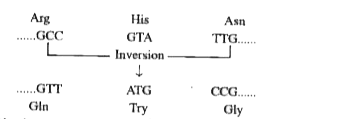Explain in detail about the types of gene mutations.Solution in Punjabi
Types of Mechanism of Gene Mutations. The smallest part of a gene that can undergo mutation is known as muton. It can be as small as a single nucleotide. Most of the gene mutations involve a change in only a single nucleotide. A gene may undergo several point mutations. This produces multiple alleles. Gene mutations occur by three methods-inversion, substitution (of two types-transition and transversion) and frameshift (of two types-insertion and deletion).
1. Inversion. A distortion of DNA by mutagen can change the base sequence of a cistron in the reverse order. The process is called inversion. The new sequence will naturally have different codons,. e.g.,

2. Substitution (Replacement). In substitution a nitrogen base is changed with another. It is of two types, transition and transversion. (i) Transition. A nitrogen base is replaced by another of its type, that is, one purine is replaced by another purine (adenine guanine) while one pyrimidine by another pyrimidine (cytosine = thymine or uracil). e.g.,

(ii) Transversion. In this a purine base is substituted or replaced by pyrinidine base and vice versa. e.g., Cytosine with Guanine (C⇔ G) Adenine with thymine (A⇔ T)

3. Frame-Shift. It is gene mutation where the reading of codons is changed. due to insertion or deletion of nucleotides. It is just like changing the sentence-The Fat Dog Ate the cat by insertion of alaphabet T. It will read-The Tfa Tdo cat Eth Eca T which is meaningless. Similarly, deletion of letter F will produce another meaningless sentence-The Atd oga Tet Hec At. Insertion of one or more nucleotides shifts the reading of nucleotide frame in the forward direction while deletion will cause a backward reading of frame. (i) Insertion. One or more nuleotides are added in the DNA segment representing a gene.

(ii) Delection. One or more nucleotides are lost from a segment of DNA representing a cistron or gene.

Nonsense, Same-sense and Mis-sense Mutations. A nonsense mutation is the one which stops polypeptide synthesis due to formation of a terminating or nonsense codon, viz., ATT(UAA), ATC(UAG), ACT(UGA). A mis-sense mutation is the one which involves change in a codon that produces a-different arnino acid at the specific site in polypeptide, often resulting in its nonfunctioning. A same-sense mutation is silent mutation in which the codon is changed but the change does not alter the amino acid specificity (e.g., GCA→GCT or GCC or GCG).
Topper's Solved these Questions
- PRINCIPLES OF INHERITANCE AND VARIATION BOOK - BETTER CHOICE PUBLICATIONCHAPTER - PRINCIPLES OF INHERITANCE AND VARIATION EXERCISE - SHORT ANSWER TYPE QUESTIONS
66 Videos
- PRINCIPLES AND PROCESSES IN BIOTECHNOLOGY BOOK - BETTER CHOICE PUBLICATIONCHAPTER - PRINCIPLES AND PROCESSES IN BIOTECHNOLOGY EXERCISE - LONG ANSWER TYPE QUESTIONS
16 Videos
- REPRODUCTION IN ORGANISMSBOOK - BETTER CHOICE PUBLICATIONCHAPTER - REPRODUCTION IN ORGANISMSEXERCISE - LONG ANSWER TYPE QUESTIONS (5 MARKS)
11 Videos
Similar Questions
Who is responsible for the sex of the new born child. Male or Female? Explain.
View SolutionWhat is recombinant DNA technology? Explain in brief the various steps in the process of recombinant DNA technology.
View SolutionExplain various artificialmethods of vegetative propagation.
View Solutionजीन म्यूटेशन क्या है ? जीन म्यूटेशन के क्या कारण है ? समझाइए ।
View SolutionMention the types of gene or point mutation.
View Solutionइन में से प्रत्येक में जीन उत्परिर्तन (Gene mutation) के प्रकार को समझाइए-
ATGCATGC -ACGCATGC
View Solutionइन में से प्रत्येक में जीन उत्परिर्तन (Gene mutation) के प्रकार को समझाइए-
ATGCATGC -ATGAATGC
View Solutionजीन उत्परिवर्तन को परिभाषित कीजिए।
View Solutionजीन म्यूटेशन की विशेषताएँ क्या हैं? समझाइए।
View SolutionMention the types of Cymose inflorescence. (or) Explain in detail about the types of cymose inflorescence.
View Solution(b) Explain in detail about various types of direct gene transfer method.
View SolutionExplain in detail about various types of extinctions.
View Solution(b) Explain in detail about heterosis and its types.
View SolutionTransition type of gene mutation is caused when .............
View Solution(b) Explain in detail about various types of direct gene transfer method.
View SolutionWhat is mutation? Explain the two types of mutation.
View Solution
